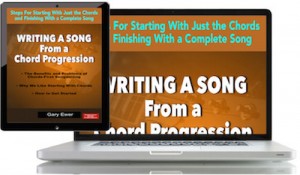 “The Essential Secrets of Songwriting 10-eBook Bundle” contains several eBooks that are meant to get you moving quickly in your songwriting process. They’ll give you progressions, formulas for creating your own, and all the info you need to add chords to an existing melody.
“The Essential Secrets of Songwriting 10-eBook Bundle” contains several eBooks that are meant to get you moving quickly in your songwriting process. They’ll give you progressions, formulas for creating your own, and all the info you need to add chords to an existing melody.
Many songwriters love the chords-first songwriting process, for several reasons:
- Chords easily create a mood. Even just getting two chords working gives you an important emotional base that can serve as a launching pad for the rest of the elements of your song.
- Chords make it easy to get a rhythmic feel happening. Setting up a rhythmic groove as a first step is fine. But creating those rhythms once you’ve got a chord progression can enhance musical meaning in powerful ways. With chords already in place, adding rhythms practically tells you what the song is about.
- Chords can imply melody, in the sense that it limits (in the best sense of that word) your choices for what your melody could be. Narrowing down melody choices by setting up chords first helps you compose something that really partners well.
However, as I’ve mentioned many times on this blog, a chords-first process comes with a kind of musical caution: chords paired up with rhythms sometimes gives the songwriter the impression that the song is basically done. (Spoiler: it’s not.)
In the pop music industry, a topliner will take an instrumental track — those chords and rhythms — and create an enticing melody. But if you’re writing “old-school” — where you are the composer from start to finish — you are the one that must compose that melody that really works well.
And that’s where the chords-first process can lead to problems. There’s no denying that a song that doesn’t have a great rhythmic-instrumental track underneath has practically no value in today’s pop music world. But a great instrumental track without a great melody has a problem: there’s not much that can bring an audience back.
These days, if you are actually working regularly in the pop music industry, you’ll know that the vast majority of songs are completed by topliners who take a great instrumental track and add their melody and lyrics above it. In today’s world, toplining is every bit as important as the produced tracks underneath it. A song with lousy instrumentals dies, and so does a song with a lousy melody.
Since melodies often get ignored in the chords-first songwriting process, here are some tips to help:
- Create chords, and then play them as many ways as possible. Try different tempos, different kinds of backing rhythms, and create different moods. Let those chords help dictate which direction your song is going to take.
- Allow the feel of the chords and instrumental track dictate what the song’s about. Let the sound of the music guide you.
- Improvise melodic ideas over the chords. Remember to allow repetition to play an important role. Find a melodic cell that you really like, and see what happens when you repeat it. How about repeating it higher, or lower? Find the melodic shape you like, and keep improvising.
- If you run out of melodic ideas, revoice the chords. Go back to your instrumental tracks and move the voicings of the chords higher and lower. The newer voicings may imply melodic ideas you hadn’t thought of before.
- Sing your melody without instrumentals. This is where you get to hear your tune with nothing but its own structure to support it. A melody with a great instrumental track underneath needs to work even if there’s nothing underneath. If you’ve got a melody that sounds great sung with no accompaniment, you’ve got a melody that will be a winner once you add the instrumentals back in.
 Written by Gary Ewer. Follow Gary on Twitter.
Written by Gary Ewer. Follow Gary on Twitter.
 To discover the most important secrets of the chords-first songwriting process, read “Writing a Song From a Chord Progression.” It’s part of “The Essential Secrets of Songwriting 10-eBook Bundle.” Get it now, along with a free copy of “Creative Chord Progressions.”
To discover the most important secrets of the chords-first songwriting process, read “Writing a Song From a Chord Progression.” It’s part of “The Essential Secrets of Songwriting 10-eBook Bundle.” Get it now, along with a free copy of “Creative Chord Progressions.”










